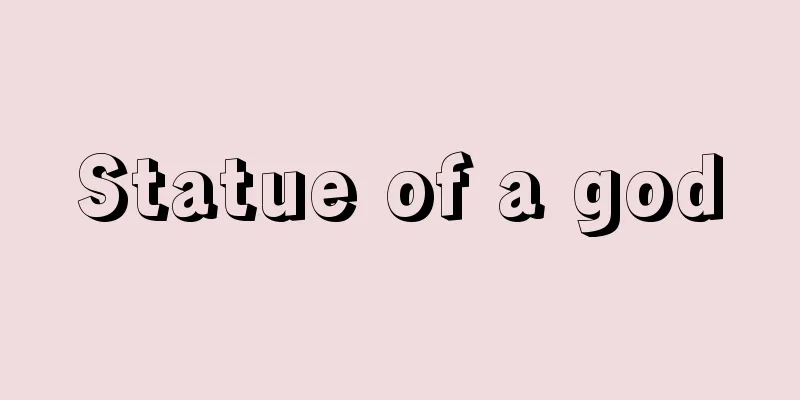Statue of a god

|
The gods of Jingi faith are depicted in sculptures, paintings, etc. [Akio Sato] JapanOriginally, Japanese belief in gods was different from Buddhism, which has statues and paintings of Buddha, and did not have idols as objects of worship. Instead, it was a totemistic worship of objects such as Ise Shrine, which worships a mirror as its deity, and a worship of natural objects such as Omiwa Shrine in Nara, which worships Mt. Miwa, and Hirotaki Shrine in Nachi, which worships Nachi Falls. The reason why gods were made as human figures or similar figures was due to the idea of Shinbutsu Shugo (mixture of Shinto and Buddhism) that arose around the 7th century with the introduction of Buddhism. In other words, in order to spread Buddhism, it was necessary to reconcile with the ancient gods. Examples of this are when Emperor Shomu welcomed Usa Hachiman from Kyushu as the guardian deity for the great project of building the Great Buddha of Todaiji Temple, and when he built a shrine temple at Ise Shrine in 766 (Tenpyo Jingo 2). This clarified the position of Japanese gods as people who rejoice in and protect Buddhism, but this idea went further, and after the Enryaku period (782-806) gods began to be given the title of bodhisattva, and in the 10th century, the honji suijaku theory was born, which states that gods are Buddhas who have changed form and "left their mark" on the land of Japan, that is, gods are one of the manifestations of Buddha. In the 11th and 12th centuries, it came to be believed that each specific god has a designated honji buddha (for example, the honji of Hachiman is Amida, and the honji of the god of Kumano Hayatama is Yakushi). The earliest records of statues of the deity include the creation of a statue of Tado Daibosatsu at Tado Jinguji Temple by the monk Mangan around 763 (Tenpyo Hoji 7), and the creation of a male statue of a horse-riding deity wearing purple clothing, a golden belt and a sword as the deity of Tsukiyomi-no-miya around 804 (Enryaku 23) in the early Heian period. There are records showing that statues of the deity were created from the end of the Nara period, but it was not until the Heian period that they became popular. The three Hachiman deities at Toji Temple in Kyoto (national treasure, late 9th century), believed to be the oldest surviving deity statues, were the objects of worship for the Hachiman Shrine, which was originally the guardian shrine of the temple. All three statues are made from the same single piece of wood, with thick layers of wood lacquer laid in parts on top of the wood base, and then painted in fairly thick layers. This technique is a vestige of the Nara period wooden core dry lacquer statues, and it is clear that they learned from the expressions and techniques of Buddhist statues. Of these, the male deity Sogyo Hachiman, as his name suggests, has the appearance of a monk, but the two female deities have a topknot, long hair that hangs down over their shoulders, and are dressed in long sleeves with a haishi over their trousers and a mo. From then on, most god statues were usually depicted as male and female aristocrats in full attire, with male gods often wearing crowns, long-sleeved robes, and holding scepters. The reason god statues tend to be more realistic is thought to be because, although god statues originated from Buddhist statues, they needed to be expressed in a completely different way from Buddhist statues because of their relationship with the original Buddhas. Also, because god statues began to be popular in the early Heian period, when single-wood Buddhist statues were at their height, the simplicity and pure dignity of traditional single-wood statues was respected even during the Fujiwara period, when the technique of inlaid wood construction was perfected, in line with the appreciation of the characteristics of plain wood construction in shrine architecture. It is thought that the same reason is why, except for the very earliest statues, painting was done directly on the wood base. However, in the Kamakura period, the samurai class used Shinto and formalized it, and the Honji Suijaku theory became more precise. As the close relationship between Shinto and Buddhism was emphasized, statues of gods were actively produced widely and gradually became more formulaic. Then, as the production of statues of gods came to be done by Buddhist sculptors and the stylized technique of inseparable wooden Buddhist statue sculpture became mainstream, the purity and simplicity of the god statues since the Fujiwara period became localized, and their divinity and dignity faded, leading to portrait sculpture or doll-like expression, and gradually declining. In addition to the works mentioned above, other representative examples of divine sculpture include the three Sogata Hachiman deities (National Treasure) at Yakushi-ji Temple in Nara, the male and female deity statues at Matsuo-taisha Shrine in Kyoto (all from the early Heian period), the Ugano Mitama no Mikoto statue at Ozu Shrine in Shiga, and the male and female deity statues at Kumano Hayatama Taisha Shrine (all from the late Heian period), the seated Sogata Hachiman deity statue at Todai-ji Temple (National Treasure, 1201, formerly the deity object of Tamukeyama Hachiman Shrine) by Kaikei, the seated Tamayorihime no Mikoto statue at Yoshino Mikumari Shrine (National Treasure, 1251), and the Izuyama Gongen statue at Hannyain Temple in Shizuoka (all from the Kamakura period). Additionally, the seated statue of Silla Myojin (a National Treasure) at Onjoji Temple in Shiga Prefecture is said to be a god worshipped in China, and is a strange-looking work from the late Heian period. There are no images of the gods dating back to the Heian period, but by the Kamakura period, there were not only simple portraits of the gods but also works depicting legends about the deities they worship. Famous examples include the "Kiyotaki Gongen" (1262), which depicts the deity worshipped at the Kiyotaki Shrine in Daigoji Temple in Kyoto, the "Kariba Myojin and Niu Myojin Statues" which depicts the local deities of Mount Koya, and the "Itae Shinzo-gaku" (Ita-e Shinzo-gaku) of the Yakushiji Temple (created by Gyōgon, 1295). As for unique statues of deities, statues of Zao Gongen, which are similar in form to the wrathful heavenly beings that En no Gyoja is said to have had an insight into, were made from around the 11th century as central figures in Shugendo, a religion born out of the connection between Buddhism and Japanese mountain worship. In the latter half of the Kamakura period, statues of En no Gyoja, the founder of Shugendo, were also made. [Akio Sato] Western and OtherWestern gods were generally depicted in sculptures and paintings in the form of human or animal figures. In particular, in ancient times, many idols were used as objects of magical rituals, but the images of the Earth Goddess that appeared in various parts of Europe from the late Paleolithic period are thought to be related to the magic of fertility and procreation. The images of gods in primitive religions reflect human thoughts about gods. For example, Ahura Mazda, the chief deity of the Iranian primitive religion Mazdaism, became the chief deity of Zoroastrianism (Zodiac worship) in the late 7th to 6th centuries BC. During the Achaemenid period, he was depicted as half a human body inside a disk with large wings spread out on both sides. During the Sassanid period, he was depicted as being on earth in the same form as a human, suggesting that when royal authority became stronger than that of the gods, the gods' images became closer to human form. It is also not uncommon for natural phenomena and plants such as trees to take on strange forms as gods, and in this case, the gods are responsible for things in their respective fields of expertise. For example, tree gods are an expression of the belief in nature spirits, and plants are a symbol of the vitality of nature. Egyptian culture is also known as the culture of tombs and temples, and during the New Kingdom, large temples to the god Amun, the patron deity of the nation, were built one after another, with images of Amun and other Egyptian gods carved into the walls and pylons. Many of the statues of ancient Egyptian gods had animal heads on human bodies. Horus was a hawk, Thoth was an ibis, Hathor was a cow, Khnum was a ram, and Min, Athm, Isis, and Osiris were often depicted in fully human form. In the ancient Mediterranean world, "snake goddesses" appeared during the Minoan civilization, but the snake is a common symbol of gods from the agricultural era. Greek statues of gods were depicted as the pinnacle of ideal human beauty, celebrating beautiful bodies rather than representing transcendence, and many statues were created from the Archaic period to the Hellenistic period. In particular, Aphrodite (Venus), the goddess of beauty, occupies an important position in art history as both a divine figure and a beautiful naked human figure. For the peoples of Central and South America who depended on agriculture, such as the Maya, Aztecs, and Incas, the main objects of worship were agricultural gods who symbolized the blessings and fertility of water. For the Maya, snakes were also symbolized as attributes of the rain god and water god, and Chaac, whose eyes are tearful, was the god of thunderstorms. The god of agriculture was represented as a young god with a crown of young ears of corn, while the god of wind and Venus was represented by a sacred bird called Quetzalcoatl. People filled stone pillars and temple walls with statues of these gods, leaving no gaps between them. Although Christianity originally prohibited the depiction of idols, it came to depict Christ as the one and only God, such as in "Christ as Almighty God" or "Christ at the Last Judgment." In areas influenced by Byzantine art, many icons were created as objects of worship, and the tradition of icons has been preserved to this day in the Eastern Church. In the Western Roman Church, icons passed through the Romanesque and Gothic periods as holy images, and flourished in the Renaissance of the 15th century in Italy. The "Madonna and Child" and "Christ" by Raphael and Leonardo continue to be regarded as typical images of God to this day. [Nao Tomobe] "Haruki Kageyama, 'Divine Statues - The Minds and Forms of the Gods' (1978, Hosei University Press)" "Naoki Oka, 'Study of Divine Statue Sculptures' (1966, Kadokawa Shoten)" [References] | |Late Period (664 BC - 332 BC or earlier) Bronze and other materials Height: 17.6 cm Collection of the Metropolitan Museum of Art Horus Late Period (664-332 BC) Lead bronze Height 45.7cm Collection of the Metropolitan Museum of Art "> Osiris Source: Shogakukan Encyclopedia Nipponica About Encyclopedia Nipponica Information | Legend |
|
神祇(じんぎ)信仰の神々を彫刻や絵画などで形に表現したもの。 [佐藤昭夫] 日本もともと日本の神信仰は、仏像や仏画を有する仏教と異なり、礼拝の対象としての偶像をもたず、伊勢(いせ)神宮が鏡を神体とするトーテミズム風の器物崇拝であったり、奈良の大神(おおみわ)神社が三輪山(みわやま)を、那智(なち)の飛滝(ひろう)神社が那智滝を礼拝の対象としているように自然物信仰であった。神々を人間像もしくはその類似像で表す神像がつくられるようになったのは、仏教伝来によって7世紀ごろからおこってきた神仏習合(神仏混交)思想による。つまり、仏教の普及のためには古くからの神々との融和が必要とされたわけで、聖武(しょうむ)天皇が東大寺大仏造立という大事業加護のために九州から宇佐八幡(はちまん)神を鎮守(ちんじゅ)神として迎えたことや、766年(天平神護2)に伊勢社に神宮寺を建立したことなどはその例である。これは日本の神も仏法を喜び守護するという立場を明らかにしたものであるが、この考えはさらに進んで延暦(えんりゃく)(782~806)以降は神々に菩薩(ぼさつ)号をつけることが始まり、10世紀ごろになると、神は仏が姿を変えて日本の地に「迹(あと)を垂れた」、すなわち神は仏の変化身(へんげしん)の一つであるという本地垂迹(ほんじすいじゃく)説が生まれた。11~12世紀には特定の神にそれぞれ定まった本地仏がある(八幡神の本地が阿弥陀(あみだ)であり、熊野速玉(はやたま)の神の本地は薬師(やくし)であるなど)とするようになる。 文献上に神像が現れるのは、763年(天平宝字7)ごろ僧満願が多度神宮寺に多度大菩薩の神像をつくったこと、平安初期の804年(延暦23)ごろ月読宮(つきよみのみや)の神体として、騎馬で紫の衣を着、黄金づくりの帯に太刀(たち)を佩(は)いた男神像が造立された例などが古い。このように奈良時代末から神像がつくられたという記録はあるが、盛んになるのは平安時代以後である。 現存する最古の神像とされる京都・東寺の八幡三神像(国宝、9世紀後半)は、もと同寺の鎮守社であった八幡社の神体で、3体とも同一材を用いた一木造(いちぼくづくり)で、木地の上に部分的に厚く木屎漆(こくそうるし)を置き、さらにかなり厚手の彩色を施す造像法をとっている。これは奈良時代の木心乾漆像の手法を残したもので、明らかに仏像の表現や技法から学んだことがわかる。このうち男神像の僧形(そうぎょう)八幡神は名のとおり僧侶(そうりょ)の姿だが、2体の女神像は髻(もとどり)をつくり、髪は長く肩に垂れ、大袖(おおそで)の上に背子(はいし)を重ね、裳(も)をつけるという装いである。以後、大部分の神像は、公家(くげ)貴族の男女が正装した姿で表されるのが通例で、男神像では冠を頂き、大袖の袍(ほう)をつけ、笏(しゃく)をとった姿が多い。このように神像が写実的傾向を示すのは、神像が仏像を源流としながら、本地仏との関係で仏像とはまったく姿を変えた表現をとる必要があったためと考えられる。また仏像の一木造の全盛期であった平安初期に神像の流行が始まったため、寄木造(よせぎづくり)の技法が完成した藤原時代にも、神像では伝統的な一木造の素朴で清純な品格が尊ばれたのは、神社建築が白木(しらき)造の持ち味を賞揚したのと軌を一にしている。彩色も、ごく初期の像を除いては、木地にじかになされているのも、同じ理由と考えられる。 しかし鎌倉時代に入り、武家が神祇を利用し、神道(しんとう)として形式づけてから本地垂迹説はいっそう精細になり、神仏の密接な関係が強調されるなかで、神像は盛んに広範囲につくられる一方、しだいに形式化していった。そして神像制作が仏師の手になるようになって、寄木造の仏像彫刻の様式手法によるものが主流になると、神像には藤原時代以来の清純素朴さは地方的なものになってゆき、神性や品格も薄れて肖像彫刻もしくは人形的な表現に堕し、しだいに衰退した。 神像彫刻の代表的なものとしては前記の諸作のほか、奈良・薬師寺の僧形八幡三神像(国宝)、京都・松尾(まつのお)大社の男女神像(以上平安初期)、滋賀・小津(おづ)神社の宇賀之御魂命(うがのみたまのみこと)像、熊野速玉大社の男女神像(以上平安後期)、快慶作の東大寺の僧形八幡神坐像(ざぞう)(国宝、1201、もと手向山(たむけやま)八幡社神体)、吉野水分(みくまり)神社の玉依姫命(たまよりひめのみこと)坐像(国宝、1251)、静岡・般若院(はんにゃいん)の伊豆山権現(ごんげん)像(以上鎌倉時代)などがある。また滋賀・園城寺(おんじょうじ)の新羅(しんら)明神坐像(国宝)は中国で信仰された神といわれ、異様な風貌(ふうぼう)をもった平安後期の作である。 神の画像は平安期にさかのぼるものは1点もないが、鎌倉時代に入ると単なる神の肖像ばかりでなく、祭神についての伝説を表したものもある。京都・醍醐寺(だいごじ)清滝(きよたき)社の祭神を描いた『清滝権現像』(1262)、高野山(こうやさん)の地主神を描いた『狩場明神・丹生(にう)明神像』、薬師寺の『板絵神像額』(堯厳(ぎょうごん)作、1295)などが有名である。 また、神像の特殊なものとしては、仏教と日本の山岳信仰の結び付きから生まれた修験道(しゅげんどう)の中心的存在として、役行者(えんのぎょうじゃ)が感得したという忿怒形(ふんぬぎょう)の天部(てんぶ)像に近い形をとる蔵王権現(ざおうごんげん)像が11世紀ごろからつくられ、鎌倉後半期に入ると修験道の開祖としての役行者像などもつくられた。 [佐藤昭夫] 西洋その他西洋の神像は一般に人間像あるいは動物像の形で彫刻や絵画に表現された。とくに古代では、呪術(じゅじゅつ)的祭祀(さいし)の対象としての偶像が多くみられるが、旧石器時代の後期からヨーロッパ各地に出現する地母神(ちぼしん)像は、豊饒(ほうじょう)と多産の呪術と関連するものとみられる。 原始宗教における神像は神々に対する人間の考え方を反映するもので、たとえばイランの原始宗教マズダ教の主神アフラ・マズダーは、紀元前7~前6世紀後半にゾロアスター教(拝火教)の主神となるが、アケメネス朝時代には、左右に大きな翼を広げた円盤の輪の中に人間の半身の形で表されている。それがササン朝には、地上に降りて人間と同じ形で表現されているが、これは、王権が神より強くなったときに、神像が人間像に近づくことを暗示している。また自然現象や樹木などの植物が神として奇怪な形をとることも珍しくなく、この場合、神々はそれぞれの分野で専門別に事物をつかさどるのである。たとえば樹神は自然霊信仰の表れで、植物は自然の生命力の象徴となる。 エジプト文化は墓と神殿の文化ともいわれ、新王国時代には国家の守護神アメン神の大神殿が次々に建設され、壁面や塔門にアメンほかエジプトの神々の像が刻まれた。古代エジプトの神像では人体に動物の頭をつける神も多い。ホルスは鷹(たか)、トトは朱鷺(とき)(イビス)、ハトホルは牝牛(めうし)、クヌムは牡羊(おひつじ)で、ミン、アトウム、イシス、オシリスなどは多くの場合、完全な人間の姿で表される。 古代地中海世界では、ミノス文明期に「蛇女神」が出現しているが、蛇は農耕時代の神に共通するシンボルである。ギリシアの神像は理想的な人間美の極致として描かれ、超越性の表象というよりは美しい肉体の賛美となり、アルカイック期からヘレニズム期にかけて多くの像がつくられている。とくに美の女神アフロディテ(ビーナス)は神像であると同時に美しい裸体の人間像として、美術史上重要な位置を占めている。 マヤ、アステカ、インカなど、中南米の農耕に依存する民族にあっては、水の恵みと豊饒力を象徴する農業神が信仰の主対象となった。マヤでも蛇が雨の神、水の神の属性として象徴され、目から涙するチャクは雷雨の神である。農耕の神はトウモロコシの若い穂を冠にした青年神で表され、風の神、金星の神はケツァルコアトルという霊鳥で表現されている。人々は石柱や神殿の壁面をすきまなくこれらの神々の像で埋め尽くした。 キリスト教では本来、偶像表現を禁止していたが、「万能の神としてのキリスト」あるいは「最後の審判におけるキリスト」のように、唯一神としてのキリストを描くようになった。ビザンティン美術の影響の及んだ地域では、聖画像(イコン)が礼拝の対象として数多くつくられ、東方教会ではイコンの伝統が守り抜かれて今日に至っている。西方ローマ教会では聖画像としてロマネスク、ゴシック期を経て、イタリア15世紀のルネサンスに花開いた。ラファエッロやレオナルドの「聖母子像」や「キリスト」は、神像の一つの典型としての意味をもち続けて今日に至っている。 [友部 直] 『景山春樹著『神像――神々の心と形』(1978・法政大学出版局)』▽『岡直己著『神像彫刻の研究』(1966・角川書店)』 [参照項目] | |末期王朝時代(紀元前664~前332年またはそれ以前) 青銅ほか 高さ17.6cmメトロポリタン美術館所蔵"> ホルス 末期王朝時代(紀元前664~前332年) 鉛青銅 高さ45.7cmメトロポリタン美術館所蔵"> オシリス 出典 小学館 日本大百科全書(ニッポニカ)日本大百科全書(ニッポニカ)について 情報 | 凡例 |
Recommend
Ikahorei - Ikahore
…It is one of the three mountains of Jomo togethe...
Chinese - Chinese
A language mainly used by the Han people, mainly ...
Motherly tone - Omochoushi
〘Noun〙 In gagaku, the six basic tones. They are Ic...
Molecular orbital method
Abbreviated as MO method. A type of approximation...
Sturnidae
…They have a raspy, 'ja, ja' sound. The S...
Atom probe field ion microscope
...In addition, the field evaporation method has ...
Ebla - Ebla (English spelling)
An ancient city-state in northern Syria. Its exis...
Diplazium tomitaroanum (English spelling) Diplaziumtomitaroanum
…[Masahiro Kato]. . . *Some of the terminology th...
Objective merger of claims - Objective merger of claims
… The simplest form is one plaintiff filing a sin...
Ichibata Yakushi
…Also, since it has been designated as part of th...
Bontoanshu
1349 (Shohei 4 | Sadawa 5) - ? A renga master from...
Regular envoy - Jyozukai
In medieval manors and provincial government terri...
Duke of Rivas
1791‐1865 Spanish poet and playwright. His real na...
Heteroptera - Ishirui (English spelling)
A general term for insects belonging to the Hemipt...
Euphorbia valida (English spelling)
… [Hiroshi Yuasa]. … *Some of the terminology tha...









